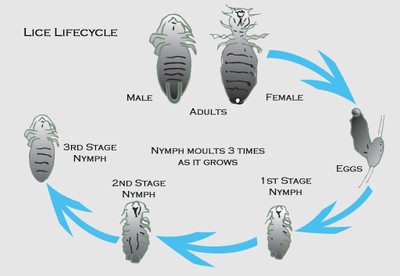Lice
| Lice (OrderPhthrirapteraa) |
|---|
|
Sucking Lice and Biting Lice |
| Putting the Bite on Lice, Ticks and Mites |
Lice populations build in the winter months, lasting from November to March. They are usually not a problem in the summer as lice cannot survive warmer temperatures. Animals with a lice infestation will scratch and lick the irritated areas. Lice spread from animal to animal by close contact and by grooming. If one animal in the herd needs treatment, all animals in the herd should be checked for lice. Ringworm and scabies can look similar to lice infestations. If you have doubt, consult your veterinarian before treatment. During severe winters, louse infested animals are more susceptible to respiratory disease.
Life Cycle
Lice spend their entire life on the host. Lice arepaurometabolouss; their life cycle includes eggs, nymphs, and adults. Depending on the species, lice can complete their life cycle in as little as 16 days.
Control Methods
Sprays and a high nutritional diet are the best means to effectively controlling lice populations. Lice eggs are not affected by insecticides. After the initial treatment, a second treatment must be made 2 to 3 weeks afterward to kill the newly emerging nymphs. If introducing new animals into the herd and you are unsure of possible lice infestations, isolating and treating and retreating before introducing could prevent a large scale outbreak.
Cattle
Biting lice
There is only one species of biting lice found in the United States. The cattle biting louse does not feed directly on the host but rather on the organic matter on the surface of the skin. The presence of the louse causes irritation and the need to scratch and rub.
Sucking lice
All sucking lice have piercing sucking mouthparts and feed on blood from the animal. There are three types of sucking lice, the short nosed cattle louse, the long nosed cattle louse and the little blue louse. Cattle will seem greasy when infested with sucking lice.
Horses and Mules
Two species of biting lice and one species of sucking lice affect horses and mules. Heavy infestations can cause anemia, unthriftiness, loss of condition, stunted growth, uneasiness, loss of hair, and sores from rubbing.
Sheep and Goats
Biting lice
Three species of biting lice effect goats and sheep, the goat biting louse, the angora biting louse, and B.limbataa. All three species of biting lice feed on hair skin and debris. The life cycle is completed in about a month with eggs hatching from 9-12 days.
Sucking lice
These blood feeding species cause the most severe damage. Excessive feeding causes scabby, bleeding areas that can lead to bacterial infections. Mohair on Angora goats may be damaged up to 50% in value. The three types of sucking lice that affect goats and sheep are: the goat sucking louse, African goat sucking louse, and sheep foot louse. Goat sucking lice can be found all over the body. The African goat sucking louse is usually found around the head and neck regions. Both the goat sucking louse and the African goat sucking louse are bluish grey in appearance. The sheep foot louse is found primarily on the feet and legs.
Swine
The most common louse found is the sucking hog louse. These lice will be found in heavy populations on the head, and around the ears. Infestations will cause scratching, scabbing, un-thriftiness and appetite loss.
Poultry
Chicken head louse spends all time on host. As the name suggests, this poultry pest spends its time on the head and neck. It can become a serious pest of young chickens and turkeys. Dusts and body sprays work well. Premise sprays will not work against lice.


